ICPE-9800 Series - Značajke
Multitype ICP Emission Spectrometers
Leading-Edge CCD Detector with One Million Pixels Capable of Simultaneous Recording of All Wavelengths
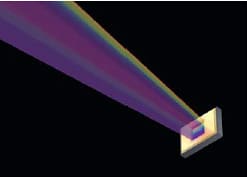
Data for all wavelengths are captured as an image formed on a two-dimensional plane using a large 1-inch CCD sensor, in the same way that a camera captures a photograph. The acquired data are saved for reviewing at any time. The wavelength can be changed after the measurement is finished, thus reducing the need to reanalyze samples and enabling faster method development. In addition, qualitative data can be read and matrix elements can be checked and corrected for, thus eliminating measurement errors due to interference.
Anti-Blooming

One-Inch Back-Illuminated CCD Detector
Since the instrument employs a back-illuminated CCD with overflow drains, it provides a broad light receiving area, while also preventing blooming
Automatic System Shutdown After Analysis
The cooling temperature of the CCD is -15°C, which means it can be used at a higher temperature than a conventional semiconductor detector (-40°C). The waiting time at shutdown that is usually required in order to prevent condensation is not necessary.
High Sensitivity and High Resolution
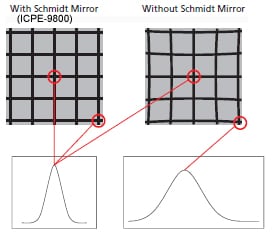
Schmidt-aberration Corrected
A Schmidt mirror is used for correcting astigmatism. Spectrometers without this function result in blurring along the perimeter of the detector, which decreases resolution and sensitivity.
Acquisition for All Wavelengths Allows You to Freely Add Elements and Wavelengths

Acquisition for All Wavelengths
Even after measurements are finished, the elements and wavelengths can be added, which allows you to confirm the quantitative or qualitative data. Because data are acquired for all wavelengths, there is no need to reanalyze samples.

The quantitative values can be displayed by simply adding elements or wavelengths. This is especially helpful when you forgot to specify an element to be measured or want to obtain data for other wavelengths.

The profiles and semi-quantitative values can be loaded and confirmed for all elements. This is useful for determining the approximate concentrations of elements that were not quantitated, for example to confirm matrices.

Once data for all wavelengths have been saved, it can be loaded and reanalyzed at any time. This availability of data provides peace of mind in case something unexpected happens with quality control or when analyzing samples that are only available in small quantities.
Three Functions Make Method Optimization Easy

Automatic Wavelength Selection
This function automatically selects the optimal wavelengths for the measurement sample based on the SB ratio and whether or not there is interference from the matrix.


Diagnosis Assistant
This function automatically checks for any problems with the method and, if any are discovered, it suggests the best way to resolve them. This allows anyone to quickly obtain accurate analytical values.
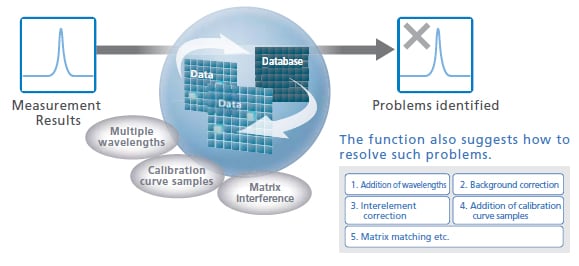

Interelement Correction
This function is useful if high-matrix samples cannot be quantitated accurately due to optical interference at all analytical wavelengths. ICPEsolution software allows users to easily perform interelement correction by simply adding a calibration sample for the interfering element to the calibration curve sample.


Method Development Assistant
This function uses the results of qualitative analysis to automatically create a method (including wavelengths and calibration curve concentrations) depending on the concentrations of the elements targeted for measurement and the matrix in the sample. User method development can be performed smoothly.
Three Features Minimize Gas Consumption, Leading to Cost Savings
ICPE-9800 systems include three features for reducing gas consumption (Eco mode, Mini-torch system, and Vacuum spectrometer), which significantly reduce the amount of argon gas consumed.
Acquisition for All Wavelengths and Assistant Functions Ensure a Smoother Analysis Process
The ICPE-9800 series' assistant functions, which combine extensive spectral data with a substantial database, enable easy optimization of methods and a simpler, more efficient analytical workflow.

System Design Helps Ensure Maximum Performance
Highly Suitable for the Analysis of a Wide Variety of Samples
Simultaneous Analysis of Trace and High-Concentration Samples Without Concern for Contamination
The torch is oriented vertically to minimize any adhesion of sample on the torch walls, thus reducing memory effects. Simultaneous analysis is possible by switching between axial and radial views.


The axial view of the ICPE-9800 series uses the photometric unit (cooling jacket plus orifice) installed perpendicular to the torch.
In axial measurements, the system causes a small amount of purge gas to flow in the axial direction in order to eliminate the upper low-temperature portion of the plasma and capture the hot portion. This prevents contamination of the photometry unit.
Analysis of High-Concentration Range and Organic Solvent Samples

Cooling Jacket Removal, Specifically for Radial View ICPE-9820
When only the radial view is used to analyze high-concentration samples or inject certain organic solvents (such as xylene), the cooling jacket can be removed to use the unit exclusively for the radial view. Removing the cooling jacket is easy.
Three Features Reduce Gas Consumption by Half
Gas Usage During Analysis and Standby Halved

Mini Torch
Mini-torch is designed to have only half the cross sectional area of standard torches. Applying the same high-frequency output to the smaller cross section increases the energy density per cross section. This improves the excitation efficiency, resulting in higher sensitivity.

Eco Mode
Reducing the high-frequency output to 0.5 kW and the plasma gas flow rate to about 5 L/min during standby saves energy and reduces costs. The analysis mode starts up smoothly as well, which enables stable analysis.
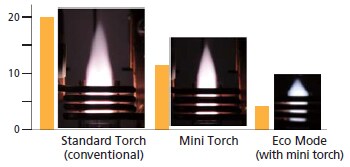
Reduced Startup Gas Consumption

Vacuum
To enable measurements of wavelengths in the vacuum UV region (below 190 nm) ICPE-9800 systems employ a vacuum pump (rotary pump) to evacuate the air and remove oxygen from inside the spectrometer. This ensures a shorter startup time in comparison to purge-type systems. When the pump stops, a solenoid valve automatically closes to maintain the vacuum inside the spectrometer. Consequently, there is no need to worry about contamination from atmospheric air flowing back into the spectrometer after the pump stops.
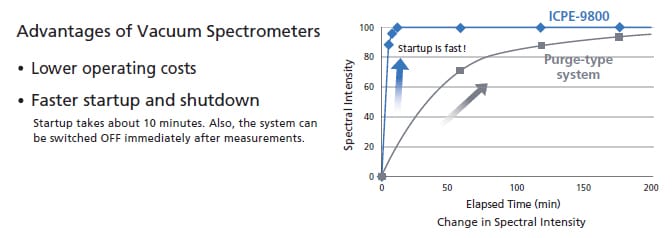
Sample Introduction System Achieves Stable Analysis for Long Periods of Time
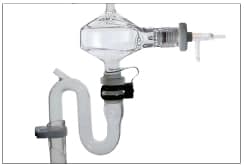
Natural Aspiration and Gravity Drain
The sample introduction system incorporates a high-accuracy nebulizer for introduction by free aspiration and a gravity drain. Therefore, a peristaltic pump is not necessary. Since there is no need to worry about a reduction in the efficiency or the variability of introduction caused by the deterioration of the pump tube, or trouble caused by improper draining, stable analysis can be accomplished for long periods of time. (If you wish to automatically add an internal standard element an optional peristaltic pump should be used.)
Elements Analyzed by the ICPE-9800



